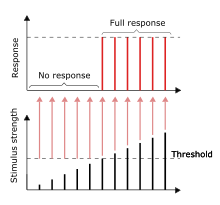All-or-none law
In
It was first established by the American physiologist Henry Pickering Bowditch in 1871 for the contraction of heart muscle.
An induction shock produces a contraction or fails to do so according to its strength; if it does so at all, it produces the greatest contraction that can be produced by any strength of stimulus in the condition of the muscle at the time.
This principle was later found to be present in
Isolation of the action potential
The first recorded time of isolating a single action potential was carried out by Edgar Adrian in 1925 from a set of crosscut muscle fibres. Using a thermionic triode valve amplifier with 1850 amplification, Adrian noticed that when the muscle preparation was left to hang, it produced oscillations; yet when supported, no such activity occurred.[3] Later with the help of Yngve Zotterman, Adrian isolated and stimulated one sensory fibre. The impulses externally on the fibre were uniform: "as simple as the dots in Morse code". Stimulus strength was manipulated and the resulting frequency measured, yielding a relationship where f∝sn [further explanation needed]. [4]
Relationship between stimulus and response

The magnitude of the
Stimuli too weak to produce a spike do, however, set up a local electrotonus, the magnitude of the electronic potential progressively increasing with the strength of the stimulus, until a spike is generated. This demonstrates the all-or-none relationship in spike production.
The above account deals with the response of a single nerve fibre. If a nerve trunk is stimulated, then as the exciting stimulus is progressively increased above a threshold, a larger number of fibres respond. The minimal effective (i.e., threshold) stimulus is adequate only for fibres of high excitability, but a stronger stimulus excites all the nerve fibres. Increasing the stimulus further does increase the response of whole nerve.
